| We're back from Jacksonville's One Spark 2015. What a great time and a great event! We met so many wonderful people and are excited about our future. And we're humbled by Popular Mechanics vote of confidence in us! Popular Mechanics named Terrapeg 1 of 6 starts up you need to know from One Spark 2015! |
|
0 Comments
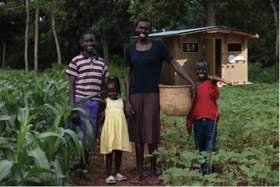 Could Shelter In A Day's disaster shelter change the world? Part 6 of a 6 part series Shelter in A Day and Terrapeg eco-friendly furniture are actively seeking new business relationships. Our breakthrough building technology has built-in adaptability with vast potential to help the less fortunate worldwide as well as unlimited applications in the developed world. The ability to build a secure, green and long lasting, furnished house, at a low cost, in a single day, completely changes the economic reality of small buildings, whatever their intended use, and Terrapeg furniture represents an emerging revolution in the furniture… and many other industries. Given the time and adaptable Terrapeg technology, I could easily develop an endless supply of new, useful and green consumer products, across a wide spectrum of markets. This phenomenal technology also represents the rarest of business opportunities, a fundamentally new, product line. There is one more idea I need to mention. Terrapeg and Shelter In A Day are technologies that can fit in a thumb drive. CNC manufacturing facilities and fiberboard plants are distributed worldwide. This means that in an emergency, intensive production can be closer to the disaster location. We can ship information, not goods, saving time, resource and transport costs. It also means that distributed manufacturing can help with the problems associated with shipping consumer goods like Terrapeg. Just imagine a kiosk in a big box store where your customer can order custom furniture by color, material and even custom carved with a school logo for instance, and have it manufactured locally and delivered to the same store for pickup. OK, You made it! If you have read this far you have an exceptional heart conveniently located below an interested mind and I look forward to communicating with you. Thank you, I hope I succeeded in lifting your spirits, and let’s keep in touch. Frank Schooley Designer; Terrapeg & Shelter In A Day READ Part 1 READ Part 2 READ Part 3 READ Part 4 READ Part 5  About Shelter In A Day | Disaster Shelters Winner of 2013 Aid and International Development Forum (AIDF) "Most Innovative Product Award." Shelter In A Day is the brainchild of eco-friendly, furniture designer Frank Schooley. Shelter's disaster recovery housing provides safe and secure, simple to construct, green homes for those displaced by natural disasters, such as hurricanes, earthquakes or floods. The disaster shelters are a solidly constructed, termite, rust and rot resistant house, with lockable doors and windows. Homes are crafted from waterproof, recycled wood fiber material and can be easily erected anywhere, in one day.
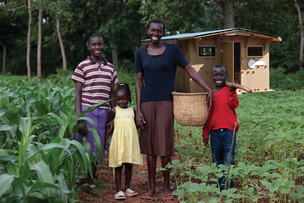 Disaster Shelter | Haiti Economic Conditions Part 5 of a 5 part series OK, a couple of details. The brick gauges can be two or three sizes. The largest brick pays more. If the chipper has an accident and chips too far, there is a medium size he can chip to. Then perhaps a small one that sells for less. The gauge is simply a rectangle and a length. The brick gauge can be in the form of a simple backpack, to help carry the load of bricks back to the collection point. I have a design in mind and it should cost no more than a decent lunch to make. Enterprising people can set up a brick yard, where rough stone is collected and chipped in one area. This has the added advantages of shortening travel times and creating another valuable commodity as a by-product, gravel, useful for concrete. This project can be started with a minimum of capital. Setting up distribution will take some capital, but not much. That capital should be readily available for any jobs project in Haiti. The individual cost of equipping one worker to start, should be far less than the cost of feeding that worker for a month. Any new export is a good thing for Haiti. Any new job created in Haiti is a plus. The ability to create a new industry in Haiti at a low cost and targeted to help the poorest, is an opportunity too good to miss. What we need now are grant writers to secure funds to get a management staff organized, technical help from people who have knowledge inside the industries we have discussed, and activists of all types to write letters to anyone with the power to help. Let’s work together and make this happen for the people of Haiti. Frank Schooley Designer; Terrapeg & Shelter In A Day READ Part 1 READ Part 2 READ Part 3 READ Part 4 READERS: What are your thoughts?  About Shelter In A Day | Disaster Shelters Winner of 2013 Aid and International Development Forum (AIDF) "Most Innovative Product Award." Shelter In A Day is the brainchild of eco-friendly, furniture designer Frank Schooley. Shelter's disaster recovery housing provides safe and secure, simple to construct, green homes for those displaced by natural disasters, such as hurricanes, earthquakes or floods. The disaster shelters are a solidly constructed, termite, rust and rot resistant house, with lockable doors and windows. Homes are crafted from waterproof, recycled wood fiber material and can be easily erected anywhere, in one day.
 Could Shelter In A Day's disaster shelter change the world? Part 5 of a 6 part series My take on accessories, water, power, solar, heating etc. is that they are best addressed according to local needs, customs and availability. Why pre-install a 110 volt power system if the local power is 220 volts? A simple power strip will do the trick. Plumbing? If you source locally, spares are available locally. Shelter In A Day is a simple, secure envelope, a blank canvas if you will. It’s simplified to bare necessities because it is not possible to be all things to all people and keep costs low, a basic, but extremely important feature. The walls are single skin, one inch thick wood, making it easy to add pipes, wires or anything else, locally. Bathroom? There are many pre-fab, drop-in water related products available. We work closely with a company who has a full line of life-support products available, everything from generators to water purification, grey water systems to mobile kitchens. So if you need anything included, just ask. 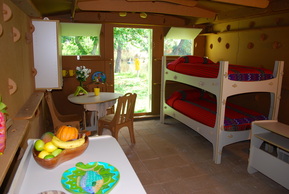 One last thing, a base model Shelter In A Day has no floor. Many do not need or want one and it’s easy to add one…using local materials. An added flooring system, of any type, is independent of the house structure. Because the Shelter has no floor, it’s easy to build without a foundation if necessary, on sand, broken ground, rubble, or even the driveway or slab of a destroyed house. Flexibility is important and local conditions and needs must take priority. A local floor system when needed, can be as simple as 2x4 joists on edge with plywood overlay, or a poured cement floor, using the walls as a form. If your specifications include a floor, just contact us. There are many options available. Decide within the next 30 days and we’ll throw in our special, screw-in, tie-down system at no extra cost. For a limited time, orders of 16 or more qualify you to also receive Terrapeg furniture at no extra cost. This includes up to five individual Terrapeg furniture pieces per house, a 1,000 US value. If you are not satisfied, just return within 2 years of shipping date for a full refund of your entire purchase price. Production is limited. Lock in your place, risk free, on our production schedule and your 30 days for the tie-down system or free furniture offer. You can change your mind at anytime during the 30 days. 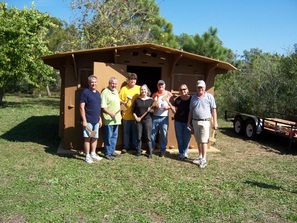 OK Frank, I’m working on my end. What else can I do? You can help in many ways, and here’s how.
What about the business end? Check back next week for Part 6. READ Part 1 READ Part 2 READ Part 3 READ Part 4 READERS: What are your thoughts?  About Shelter In A Day | Disaster Shelters Winner of 2013 Aid and International Development Forum (AIDF) "Most Innovative Product Award." Shelter In A Day is the brainchild of eco-friendly, furniture designer Frank Schooley. Shelter's disaster recovery housing provides safe and secure, simple to construct, green homes for those displaced by natural disasters, such as hurricanes, earthquakes or floods. The disaster shelters are a solidly constructed, termite, rust and rot resistant house, with lockable doors and windows. Homes are crafted from waterproof, recycled wood fiber material and can be easily erected anywhere, in one day.
 Could Shelter In A Day's disaster shelter change the world? Part 4 of a 6 part series Terrapeg is an award winning furniture line I developed first. It was the inspiration, along with the Haiti earthquake, for Shelter In A Day. It uses the same sustainable fiberboard materials, CNC cutting, and tool-free joint as the Shelter. It ships flat, is easy and even fun to assemble without tools (just the fiberboard hammer we supply), and comes in a variety of designs. We can even create a design to suit your needs. Beds, tables, chairs, student desks or church pews, in short, anything and everything you might need to furnish your new building we can supply with Terrapeg designs. This unique furniture is normally packed first on the bottom of the shipping pallet and then your building is stacked on top. (P.S. I just finished a design for what I call…wait for it… Outhouse In A Day) 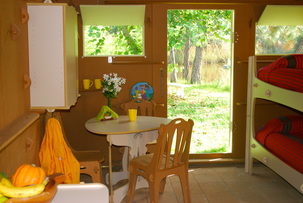 Here’s the really important idea. It’s now possible to build a furnished home or a furnished clinic or a furnished school / church…in an afternoon. This literally changes everything for aid recipients as well as aid donors. Think about what this would mean to someone, anyone in need of a place to live Now, not next month. When disaster strikes, just forklift a complete, furnished home from a central warehouse onto a standard truck, drop it anywhere it’s needed, assemble the building in a few hours, knock the furniture together, move in and lock up. This will cost less than FEMA spends just to move a trailer to a disaster site, much less than buying that trailer. Compared to trailers, an organization like FEMA will save money even if we deployed Shelter In A Day in a disaster response and then allowed them to become private storage sheds when no longer needed as immediate housing. Shelter In A Day with Terrapeg furniture is inexpensive enough to work well with micro financing. As an example, the mortgage payment for a 7000 (US), 30 year note @7% would be just 47/month. Just think what this could mean in Africa, the favelas of Rio, Haiti or the slums of Soweto. Even furnished this is about 1.50 US a day. A furnished house for the price of a sandwich, can you imagine? Yes…we can afford to end homelessness. What about water, power, solar? Check back next week for Part 5. READ Part 1 READ Part 2 READ Part 3 READERS: What are your thoughts? 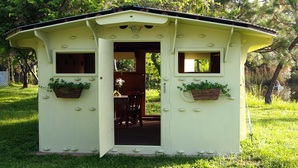 About Shelter In A Day | Disaster Shelters Winner of 2013 Aid and International Development Forum (AIDF) "Most Innovative Product Award." Shelter In A Day is the brainchild of eco-friendly, furniture designer Frank Schooley. Shelter's disaster recovery housing provides safe and secure, simple to construct, green homes for those displaced by natural disasters, such as hurricanes, earthquakes or floods. The disaster shelters are a solidly constructed, termite, rust and rot resistant house, with lockable doors and windows. Homes are crafted from waterproof, recycled wood fiber material and can be easily erected anywhere, in one day.
 Disaster Shelter | Haiti Economic Conditions Part 3 of a 5 part series I’ve mentioned several ideas previously and introduced some concepts like the importance of cement in the Haitian economy. Let’s go a step farther. There are many in Haiti who don’t have enough to eat. This is mostly because they do not have a paying job. For the under-educated or the unfortunate there is sometimes agriculture but harvest is always too far away and the kids are hungry since yesterday. I mentioned that limestone is everywhere underfoot. I have never seen so many rocks as I saw everywhere in Haiti. Limestone is fairly soft and the type found in Haiti is generally lightweight and very workable. Lets imagine that just three tools became available to anyone who wanted them, first, a rock hammer, second, a pair of plastic safety glasses and third, a simple gauge, to determine the standard size for a hand-chipped, limestone brick. With these three things, costing probably no more than $20-30 US, anyone who wanted to, wherever they are, could go to work for themselves, in Haiti. It works like this: Walk out to where the rocks are (almost anywhere in Haiti), pick up a likely stone, chip it till it’s the right length and fits through the standard brick gauge and bring it to a central collection point, located wherever they sell bags of cement. At the collection point your bricks are converted into cash and the chipper can convert the cash into a meal or anything else they need. The cement seller pays for and gathers bricks, stacking them on the same pallets the cement bags he sells were on. Remember when I mentioned one-way cement powder shipping? When the next otherwise empty cement-bag truck heads back to the dock, the (palletized) bricks are aboard. When the next otherwise empty (lighter) vessel returns to the ship in the bay, the bricks are aboard. When the ship returns to its home port, the bricks are aboard and become a commodity on the world market, a hand chipped, beautiful, limestone brick, imported from Haiti (at very little cost). Some bricks will stay and be used in Haiti. We need not concern ourselves with that. A commodity always finds its best market. They can help to stretch that next bag of cement, and they are light colored and beautiful. Cement architecture always needs the help of a beautiful, hand-chipped brick to brighten it up a bit. Haiti can export a commodity (limestone) it has too much of. Anyone who wants work can hire themselves. Under-utilized resources are put to work. It’s a win-win situation for everyone. If I go to Home Depot to buy bricks, which would I choose: the squared-off factory-made cement one or the hand chipped limestone one at about the same price…Hmmm. There are a few details that bear mentioning. Check back for Part 5 of my 5 Part Series on Disaster Shelter | Haiti Economic Conditions. READ Part 1 READ Part 2 READ Part 3 READERS: What are your thoughts?  About Shelter In A Day | Disaster Shelters Winner of 2013 Aid and International Development Forum (AIDF) "Most Innovative Product Award." Shelter In A Day is the brainchild of eco-friendly, furniture designer Frank Schooley. Shelter's disaster recovery housing provides safe and secure, simple to construct, green homes for those displaced by natural disasters, such as hurricanes, earthquakes or floods. The disaster shelters are a solidly constructed, termite, rust and rot resistant house, with lockable doors and windows. Homes are crafted from waterproof, recycled wood fiber material and can be easily erected anywhere, in one day.
 Could Shelter In A Day's disaster shelter change the world? Part 3 of a 6 Part Series Just imagine how many ways our disaster shelter will change the lives of homeless people everywhere. It’s now possible for your group, club or congregation to take up a collection, buy and ship a complete structure, fly down for a weekend to wherever it’s needed, take a day and build it, turn it over to a family, community or church… and be home for work on Monday, with the astonishing pictures. No need for you to wonder where your money went. No need to worry it was diverted, misused or wasted. Just imagine the satisfaction of knowing you helped someone in need easily and directly. Imagine if we multiplied your satisfaction by hundreds…even thousands. What if every church congregation in the US sent just one house to Haiti? Wouldn’t that feel fantastic. We could with your help. Just think of the changes to peoples’ lives if housing and security concerns were gone. Suddenly, they would have time for more productive projects... like providing for their family. I’m working closely, with Community Mission for Hope, a non-profit engaged in medical and educational missions to Haiti, on funding initiatives to build two schools and an orphanage in Haiti. The first school, located near Jeremie across a bridgeless river and up on a hill where there are no roads, is a good match with Shelter In A Day because everything must be hand carried across the river to the site. I figure construction for the school classrooms and kitchen building, for 100 kids, will take just a few days. The orphanage in Petit Groave we want to build, again for about 100 kids will take a bit longer but features a school, cabins, mess hall and a for-profit bakery, shower rooms and septic field. Quick build times save money in many ways. That’s the power of Shelter In A Day. Wanna help?  Ok Frank, you’ve got my attention… but what does it cost? You would think that a building that was this innovative, that saved so much money, would cost more than standard construction. Remember, this is not some temporary, get people under a roof, any roof, transitional shelter. Shelter in A Day is a permanent, solid wood, strongly built house. But it doesn’t cost more. In fact it costs less. Since it is computer cut to save labor costs, is made from recycled wood fiber which is plentiful and low cost, is not assembled at a factory, stacks in a small bundle and goes up in an afternoon, it saves your hard earned money at every step. Everything is included, hardware, doors, locks and windows, even those vital screens. There are no hidden costs and nothing for your team to scramble around trying to find except for roofing, and maybe flooring... we’ll get to those in a minute. Just think, this house would be a bargain at 10k, (USD) but in fact, it costs half that, just 5k for the base model with a 12x12 ft. floor plan. Yes, this home costs less than the price of a decent used car. Here are some specifications: (Don’t get distracted with the details because I still have something important to tell you about.) Footprint, base model: 12x12x8 feet tall, 144 sq. ft. Ship wt. 3000# (3.66x3.66 x2.44m, 13.4 sq.m 1366kg) Ships: palletized for forklift handling…48x91x40 inches total (1.2x2.4x1m) Center, add-on extensions are: (allows footprints extended to 12x16, 12x20, 12x24, 12x26 etc.) 4ft, 48 sq.ft. each 600# (1.22m, 4.46 sq.m. each 272kg) Each extension adds 6 inches to pallet height Shelter ships: 8 ea. Per 20 ft. standard shipping container, 16ea. Per 40 ft. Extensions are 995.(US), each 4 feet. There is no practical limit to how many extensions you can add to building length. Building width is limited to 12 feet (3.66m) due to material size.  Since we’re looking at details, it’s time to talk about the roof. Shelter In A Day’s roof is structural, but not waterproof. There are several good ways to handle the waterproofing depending on intended use and local practice and it’s cheaper and better for a variety of reasons to source it locally. Roofing options: The least expensive and easiest roof comes in a five gallon bucket of trailer type roof paint. It is light colored, reflects sun and heat, inexpensive (about $100 in the US) and is very easy to apply. Low cost and it works great as long as you do not want to disassemble the building later. A steel roof is best for the tropics where heat gain is an issue. It is inexpensive, (about $350 in the US depending on size) long lasting, locally sourced and simple to install. Just attach 3, 2 inch tall wood battens on each side of the roof and attach the steel. Because it is 2 inches above the structural roof and allows heat to escape, the Shelter stays as cool as a cave inside, even in the hottest sun. Suppose you want the option of moving or storing the building between uses for refugee populations, military uses or disaster relief, then a canvas roof is best. A military specification tarp or a truckers’ tarp will work well and installation is simple because the building structural members are pre-drilled for tie-downs. (Price will depend on specs and building length but budget $300-500 in the US.) OK, I said I’d tell you something important…here we go… READERS: What are your thoughts? READ Part 1 READ Part 2 Check back next week for Part 4  About Shelter In A Day | Disaster Shelters Winner of 2013 Aid and International Development Forum (AIDF) "Most Innovative Product Award." Shelter In A Day is the brainchild of eco-friendly, furniture designer Frank Schooley. Shelter's disaster recovery housing provides safe and secure, simple to construct, green homes for those displaced by natural disasters, such as hurricanes, earthquakes or floods. The disaster shelters are a solidly constructed, termite, rust and rot resistant house, with lockable doors and windows. Homes are crafted from waterproof, recycled wood fiber material and can be easily erected anywhere, in one day.
 Disaster Shelter | Haiti Economic Conditions Part 3 of a 5 part series Solar powered cement production has been proven possible and, as a bonus, can be done not just efficiently, but without producing waste carbon dioxide, CO2, the greenhouse gas normally produced in this industrial process. The details are complicated but to quickly sum up this exciting new research, it’s possible to cheaply produce cement using solar power, in an environmentally cleaner way, producing less or no greenhouse gas by-products (CO2) and, as a bonus, the chemical reaction gives off carbon monoxide (CO) which is used as a raw material with a wide range of industrial applications. This by-product is in theory worth more than it costs to produce the cement, making the cement production (practically) free with the assumption that the CO gas can be collected and sold. From Nanowerk.com: ‘The research team, led by Stuart Licht, a professor of chemistry at George Washington University, has now presented a solar-powered process to produce cement without any carbon dioxide. In a paper (accepted manuscript) in the April 5, 2012 online edition of Chemical Communications ("STEP Cement: Solar Thermal Electrochemical Production of CaO without CO2 emission"), they show that STEP-produced cement operates at solar energy conversion efficiencies higher than that in any solar photovoltaic. ‘  I know, it makes my head hurt too. The simple version is, solar thermal cement not only works but can work far better and cleaner than current production methods. This could change everything for Haiti... and the whole world, come to think about it. Just think what it would mean if the cost of a bag of cement was suddenly half cost. Haiti has plenty of available labor and so many projects that need building. Dams, reservoirs, roads, bridges, houses, all would be in reach if cement was affordable. Standards of living would rise along with jobs availability. Infrastructure projects would stimulate the economy in a thousand ways. Haitians know how to build and love to build. Inexpensive materials are the key to unlock the potential of the people of Haiti and practically free cement is now theoretically possible. One final thought. Aid organizations and finance operations like the World Development Bank have money available for Developing World infrastructure projects that make sense financially. This project, that creates the building blocks of every subsequent infrastructure project in Haiti, should have little trouble gathering the support of those who make the planning of long-term strategy their business. OK Frank, this is a bit long term. What about the short term problem of jobs in Haiti? I’ve got at least one idea, in next week's Part 4. I call it: Haiti… One Brick At A Time. READ Part 1. READ Part 2.  About Shelter In A Day | Disaster Shelters Winner of 2013 Aid and International Development Forum (AIDF) "Most Innovative Product Award." Shelter In A Day is the brainchild of eco-friendly, furniture designer Frank Schooley. Shelter's disaster recovery housing provides safe and secure, simple to construct, green homes for those displaced by natural disasters, such as hurricanes, earthquakes or floods. The disaster shelters are a solidly constructed, termite, rust and rot resistant house, with lockable doors and windows. Homes are crafted from waterproof, recycled wood fiber material and can be easily erected anywhere, in one day.
 Could Shelter In A Day's disaster shelter change the world? Part 2 of a 6 part series Can a building be versatile enough to be useful for disaster relief, nation building, displaced populations, military personnel housing and storage, and backyard sheds without looking like a greenhouse, steel oven box, tent or yurt? What would a better, cheaper, faster building look like? What should it do? Here’s a wish list for immediate housing:
Would you believe this house exists! How was it done? What’s changed?
I have been a cabinetmaker for over 45 years. My kitchen shop has a computerized (CNC) router, a relatively new technology that cuts all my cabinets, saving time, mistakes and money. With the collapse of the building industry in 2008, I found the time to take up my longstanding dream and began designing furniture to be cut with the CNC router. I was cutting fiberboard because it was the least expensive material I could get to practice with. Slowly, I came to respect this seldom used material. To get around fiberboards’ connecting problem, I re-invented an old-style carpenter’s joint, the mortise and through-tenon with locking peg, making it possible to cut all the parts using a CNC router. This new Tool Free joint is designed to be assembled without metal fasteners, using just a hammer, cut from the same fiberboard material. The joint overcomes the connecting problems of the material and magnifies all its strengths. It forms a connection that has proven to be both easy to assemble and surprisingly strong, allowing the use of fiberboard for structural applications for the first time. These three leaps forward, (the ‘Green’ fiberboard material, the new joint, and precise cutting with a CNC router) working together, make Shelter In A Day a breakthrough development and an innovative, new technology. According to World Population Balance website, our world population will add an average of 200,000 people every day. Additionally, millions, even billions of people now have unsafe, substandard housing made from found materials (that’s a nice word for junk). All these people need housing and this housing should be made from sustainable materials if we care about our future generations. Sustainable materials are used and reused and easily replaced, are natural in origin, are grown, not mined, and familiar to people In February, my Shelter won a People’s Choice Award at the Inventors Fair in Palm Beach. This spring, Shelter In A Day took the really big prize, Most Innovative Product, from the very people who really know the Disaster Relief World, in a landslide vote by this year’s participants at the Aid and International Development Forum in Washington, D.C. Can I really build a house, school, clinic or church…in an afternoon? Check back next week for Part 3. Read Part 1. READERS: What are your thoughts?  About Shelter In A Day | Disaster Shelters Winner of 2013 Aid and International Development Forum (AIDF) "Most Innovative Product Award." Shelter In A Day is the brainchild of eco-friendly, furniture designer Frank Schooley. Shelter's disaster recovery housing provides safe and secure, simple to construct, green homes for those displaced by natural disasters, such as hurricanes, earthquakes or floods. The disaster shelters are a solidly constructed, termite, rust and rot resistant house, with lockable doors and windows. Homes are crafted from waterproof, recycled wood fiber material and can be easily erected anywhere, in one day.
|
Disaster Relief Housing Blog
Follow Shelter In A Day’s disaster relief housing blog to stay update to date on global disaster relief efforts and how you can help those displaced by natural disasters. Archives
April 2015
Categories
All

Shelter In A Day
Fill out our quick form today. Housed Inside Tropical Kitchens Fort Myers 12451 Metro Parkway, #101 Fort Myers, Florida 33966 (239) 768-3600 |


